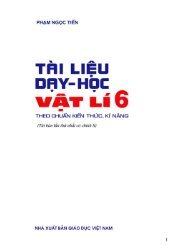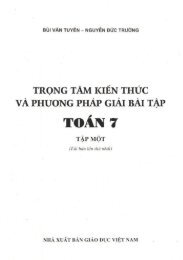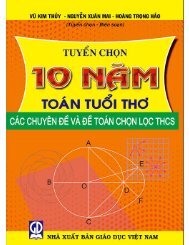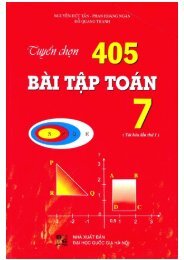- Page 1 and 2:
Lê Hoàng An (Chủ biên) Nguyễ
- Page 3 and 4:
LỜI NÓI ĐẦU Thiết kế Bài
- Page 5 and 6:
Phương án 2: Chơi trò chơi
- Page 7 and 8:
Hoạt động 4: Match the words w
- Page 9 and 10:
Giáo án 2: Unit 1: My new school
- Page 11 and 12:
Nếu còn thời gian, GV có th
- Page 13 and 14:
1 Write the correct form of the ver
- Page 15 and 16:
8 Write it up or Speak it out. Vớ
- Page 17 and 18:
a. GV cho HS thảo luận nhóm 4,
- Page 19 and 20:
Phương án 3: Gather the class’
- Page 21 and 22:
Giáo án 6: Unit 1: My new school
- Page 23 and 24:
- HS sử dụng các câu hỏi th
- Page 25 and 26:
Vocabulary 1 Tell Ss to write the w
- Page 27 and 28:
Giáo án 1: Unit 2: My home Lesson
- Page 29 and 30:
Bài tập 1b - What might they tal
- Page 31 and 32:
ehind in front of under Phương á
- Page 33 and 34:
- Blue and Green, please listen to
- Page 35 and 36:
Hoạt động 2: Name the rooms of
- Page 37 and 38:
Homework (2 minutes) 1. Do Exercise
- Page 39 and 40:
Example: 1. There isn’t a sofa in
- Page 41 and 42: Giáo án 4: Unit 2: My home Lesson
- Page 43 and 44: Lời dẫn: - Who is A, raise your
- Page 45 and 46: Hoạt động 3: Read (20 minutes)
- Page 47 and 48: Giáo án 6: Unit 2: My home Lesson
- Page 49 and 50: Body Conclusion The Tiger is betwee
- Page 51 and 52: Giáo án 7: Unit 2: My home Lesson
- Page 53 and 54: Key: 1. Vocabulary: Exercise 1 (p.
- Page 55 and 56: Giáo án 1: Unit 3: My friends Les
- Page 57 and 58: - So, how do we say when we want to
- Page 59 and 60: Trình bày bảng Monday, May 25th
- Page 61 and 62: Hoạt động 2: Teaching new word
- Page 63 and 64: - We say: Does he has or does he ha
- Page 65 and 66: Giáo án 3: Unit 3: My friends Les
- Page 67 and 68: Key: 1. is taking 2. isn’t going
- Page 69 and 70: Lời dẫn: - Today we will have a
- Page 71 and 72: Independent: Tuan is a very indepen
- Page 73 and 74: . GV giới thiệu bài quảng c
- Page 75 and 76: Homework (2 minutes) - Write an e-m
- Page 77 and 78: 2 Which activities do you think may
- Page 79 and 80: Homework (2 minutes) - Rewrite the
- Page 81 and 82: LOOKING BACK Vocabulary 1 Ss can ch
- Page 83 and 84: So với những Project của các
- Page 85 and 86: Giáo án 1: Unit 4: My neighbourho
- Page 87 and 88: 2. a. Shall we go there first? b. O
- Page 89 and 90: Giáo án 2: Unit 4: My neighbourho
- Page 91: - Who can practise with me first? -
- Page 95 and 96: Homework (2 minutes) 1. Study Box o
- Page 97 and 98: Hoạt động 3: Audio guide for y
- Page 99 and 100: Giáo án 5: Unit 4: My neighbourho
- Page 101 and 102: 1. It is in the suburbs of Da Nang
- Page 103 and 104: Giáo án 6: Unit 4: My neighbourho
- Page 105 and 106: - … Now listen to the conversatio
- Page 107 and 108: Giáo án 7: Unit 4: My neighbourho
- Page 109 and 110: Key: 1. Vocabulary 1.1 Exercise 1 (
- Page 111 and 112: Giáo án 1: Unit 5: Natural Wonder
- Page 113 and 114: Bài tập 1a GV cho HS brainstorm
- Page 115 and 116: - One is a foreign tourist; the oth
- Page 117 and 118: Key: 1. painkillers 2. scissors 3.
- Page 119 and 120: Giáo án 3: Unit 5: Natural Wonder
- Page 121 and 122: Lời dẫn: - Besides short adject
- Page 123 and 124: Giáo án 4: Unit 5: Natural Wonder
- Page 125 and 126: Kết bài (2 minutes) Through the
- Page 127 and 128: Hoạt động 2: Comprehension Rea
- Page 129 and 130: Hoạt động 4: Homework (Giao b
- Page 131 and 132: Sau khi chơi xong, GV có thể h
- Page 133 and 134: Lời dẫn: - Everyone, after you
- Page 135 and 136: 135
- Page 137 and 138: • Phần Project này GV đã gia
- Page 139 and 140: - In 2 minutes, the team with more
- Page 141 and 142: - In order to tell about your hobbi
- Page 143 and 144:
- Well done! I’m pleased that you
- Page 145 and 146:
Key: /s/: blossoms, summer, rice, c
- Page 147 and 148:
Giáo án 3: Unit 6: Our Tet holida
- Page 149 and 150:
Exercise 3 (p. 62) - Now, let’s t
- Page 151 and 152:
- Now we’ll move to Exercise 3. -
- Page 153 and 154:
Phương án 2: Kim’s game - Have
- Page 155 and 156:
Homework (2 minutes) 1. Do Exercise
- Page 157 and 158:
Phương án 2: Slap the board - In
- Page 159 and 160:
Đối với HS khá giỏi, GV có
- Page 161 and 162:
Giáo án 6: Unit 6: Our Tet holida
- Page 163 and 164:
Giáo án 7: Unit 6: Our Tet holida
- Page 165 and 166:
Key: 1. Vocabulary 1.1 Exercise 1 (
- Page 167 and 168:
GV cho HS viết lên các tấm po
- Page 169 and 170:
Lê Hoàng An (Chủ biên) Nguyễ
- Page 171 and 172:
LỜI NÓI ĐẦU Thiết kế Bài
- Page 173 and 174:
Hoạt động 2: Elicit the dialog
- Page 175 and 176:
Hoạt động 4: Use suitable word
- Page 177 and 178:
Bài tập 2 Bài tập 3 GV cho HS
- Page 179 and 180:
Homework (2 minutes) - Practise say
- Page 181 and 182:
- Now, please do more practice on q
- Page 183 and 184:
Bài tập 5 Lời dẫn: Sometimes
- Page 185 and 186:
Giáo án 4: Unit 7: Television Les
- Page 187 and 188:
Hoạt động 7 . Bài tập 4 V
- Page 189 and 190:
3. instructor (n): /ɪnˈstrʌk.tə
- Page 191 and 192:
Hoạt động 4: Homework Giao bà
- Page 193 and 194:
Hoạt động 3: Writing (25 minut
- Page 195 and 196:
27
- Page 197 and 198:
Giáo án 1: Unit 8: Sports and Gam
- Page 199 and 200:
- Well, sometimes it’s a sport an
- Page 201 and 202:
Giáo án 2: Unit 8: Sports and Gam
- Page 203 and 204:
Giáo án 3: Unit 8: Sports and Gam
- Page 205 and 206:
Hoạt động 3: (18 - 20 minutes)
- Page 207 and 208:
Giáo án 4: Unit 8: Sports and Gam
- Page 209 and 210:
At the Singapore SEA Games, Vien wo
- Page 211 and 212:
- Well, thank you for all your answ
- Page 213 and 214:
Giáo án 6: Unit 8: Sports and Gam
- Page 215 and 216:
- Now base on the listed ideas and
- Page 217 and 218:
49
- Page 219 and 220:
• HS đính các tấm poster c
- Page 221 and 222:
Hoạt động 2: Elicit the dialog
- Page 223 and 224:
Châu Á Antartica Nam Mỹ South A
- Page 225 and 226:
Giáo án 2: Unit 9: Cities of the
- Page 227 and 228:
Activity 4: - Let Ss practise the s
- Page 229 and 230:
Now, please read the facts to check
- Page 231 and 232:
- Use the Grammar box to explain th
- Page 233 and 234:
- Let Ss listen and repeat the surv
- Page 235 and 236:
Heritage sites in Viet Nam? Yes, ve
- Page 237 and 238:
Giáo án 5: Unit 9: Cities of the
- Page 239 and 240:
- Explain the task. Ss can choose o
- Page 241 and 242:
4. F (All Nobel prizes, except for
- Page 243 and 244:
Giáo án 7: Unit 9: Cities of the
- Page 245 and 246:
Hoạt động 2: Project (20 to 25
- Page 247 and 248:
Hoạt động 2: Elicit the dialog
- Page 249 and 250:
Key: 1- c 2- a 3- e 4- b 5- d - Can
- Page 251 and 252:
Phương án 2: Chơi trò chơi
- Page 253 and 254:
Key: Sound /dr/: drive drops drip d
- Page 255 and 256:
+ We say ‘He will travel to the M
- Page 257 and 258:
Giáo án 4: Unit 10: Our Houses in
- Page 259 and 260:
Giáo án 5: Unit 10: Our Houses in
- Page 261 and 262:
Homework (2 minutes) 1. Practise re
- Page 263 and 264:
Key: Linda: 3. sea view 4. swimming
- Page 265 and 266:
Giáo án 7: Unit 10: Our Houses in
- Page 267 and 268:
1.2 Bài tập 2 (p. 46) 1. robot c
- Page 269 and 270:
Giáo án 1: Unit 11: Our greener w
- Page 271 and 272:
Bài tập 2 GV cho HS làm việc
- Page 273 and 274:
Giáo án 2: Unit 11: Our greener w
- Page 275 and 276:
Reduce Reuse Recycle rubbish, plast
- Page 277 and 278:
Giáo án 3: Unit 11: Our greener w
- Page 279 and 280:
Với HS lớp khá giỏi, GV có
- Page 281 and 282:
Giáo án 4: Unit 11: Our greener w
- Page 283 and 284:
T shows 8 questions of the survey a
- Page 285 and 286:
Giáo án 5: Unit 11: Our greener w
- Page 287 and 288:
Hoạt động 3: Speaking (10 minu
- Page 289 and 290:
Giáo án 6: Unit 11: Our greener w
- Page 291 and 292:
Activity 2: - Ask Ss to read the st
- Page 293 and 294:
Giáo án 7: Unit 11: Our greener w
- Page 295 and 296:
Hoạt động 2: Project (20 to 25
- Page 297 and 298:
Giáo án 1: Unit 12: Robots Lesson
- Page 299 and 300:
Key: 1. c 2. d 3. a 4. b - And here
- Page 301 and 302:
Giáo án 2: Unit 12: Robots Lesson
- Page 303 and 304:
Hoạt động 4: Pronunciation of
- Page 305 and 306:
. Practice: Bài tập 1, 2, 3 (p.
- Page 307 and 308:
Giáo án 4: Unit 12: Robots Lesson
- Page 309 and 310:
Now it’s time for you to talk abo
- Page 311 and 312:
Key: 1. A robot show. 2. Young peop
- Page 313 and 314:
Giáo án 6: Unit 12: Robots Lesson
- Page 315 and 316:
- Now apply this form of writing an
- Page 317 and 318:
Key: 1. Vocabulary: 1.1 Bài tập
- Page 319 and 320:
Homework (2 minutes) 1. Share your









